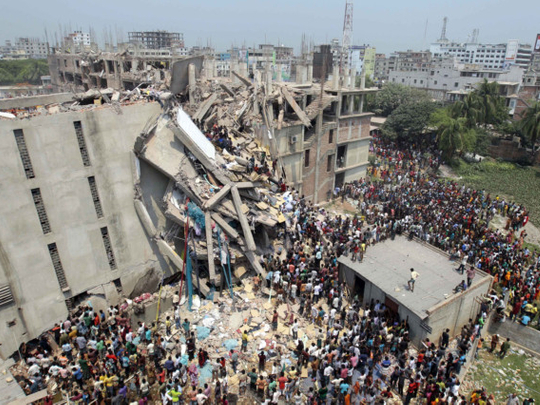
Last week, more than 300 people were killed in the collapse of a building that housed clothing manufacturers in the Dhaka region of Bangladesh. Many dozens more may still be buried in the rubble. Just five months earlier, 112 workers died in another factory fire, bringing the death toll there in recent years to at least 1,000. These buildings often lacked permits, weren’t built to code, had major structural issues and housed an industry that put profits before people.
Such conditions recall the infamous 1911 Triangle fire in New York City that killed 146 workers. The Triangle Waist Company made ‘shirtwaists’, or women’s blouses. It forced employees to work six days a week on the ninth and tenth floors of a building in the heart of Greenwich Village. At closing time on Saturday, March 25, a fire — most likely ignited by a lit cigarette — started in a bin of waste cloth or rags on the eighth floor. Workers rushed for the stairs and elevators. They notified management on the 10th floor, but no one alerted the workers on nine.
By the time the trapped workers realised what was happening, there was no escape. Oil canisters stored in a stairwell quickly fed the fire. A door was chained shut, the elevator cable seized in the heat and fire escapes separated from the building, sending workers to their death.
With little choice but to burn, many of those trapped on the ninth floor choose to jump to their deaths. W.G. Shepherd, a UPI reporter, wrote at the time: “I learned a new sound — a horrible sound. It was the thud made by a speeding, living body on a stone walk. Thud-dead! Thud-dead! Thud-dead! Thud-dead! 62 thud-deads! I call them that, because the sound and the thought of death came to me, each time, at the same instant. There was plenty of chance to watch them as they came down; the height was 80 feet.”
Huge strikes in 1909 and 1910 had shut down the garment industry in New York, bringing tens of thousands of workers into the streets to demand better conditions. This didn’t help the workers at Triangle, which remained non-union. The 1911 fire changed everything.
First, the tragedy occurred in a middle-class neighbourhood, Greenwich Village, not the immigrant slums of the Lower East Side or Little Italy. It was visible. Middle-class women strolling the fashionable streets witnessed a horrible scene.
The fire also sparked a political awakening that united struggling workers and morally responsible consumers. Many middle-class women recognised that they had a connection to the workers who made their clothes, resulting in a coalition of shoppers and factory workers.
Call to action
This movement soon forced the state to take action. In 1911, New York State’s government wasn’t known for purity or humanitarianism. Tammany Hall, the corrupt wing of the Democratic Party, was run by Al Smith and Robert Wagner, the so- called Tammany Twins. They were hacks, but they recognised a winning political issue.
Tammany created the Factory Investigating Committee, co- chaired by the twins. Smith was speaker of the assembly and Wagner led the state Senate. They saw the issue as a way to gather votes.
From 1911 to 1915, they passed dozens of laws that transformed manufacturing and provided a baseline for safety and health. They empowered the fire and building departments to conduct inspections and require fire escapes, sprinklers and drills. Many modern workplaces feature occupancy limits, floor fire marshals and fire-proof stairwells.
Today, we take these safety precautions for granted, but it took the death of 146 mainly young immigrant women to reach this point. And, rather than crush the economy or destroy industry, the regulation propelled economic growth and social stability for generations.
Bangladesh today, like New York 100 years ago, is a leading producer of US clothing. Most of the major labels we wear pass through factories such as the one where tragedy struck this week, thanks to an elaborate global network of outsourcing, middlemen and suppliers.
And while these factories may seem immune to change, the Triangle fire is a powerful lesson from our economic past that might point to a better future.
— Washington Post
Richard Greenwald is a professor and dean at St Joseph’s College in New York. He is the author of The Triangle Fire, the Protocols of Peace and Industrial Democracy in Progressive Era New York and Labor Rising: The Past and Future of American Working People.









